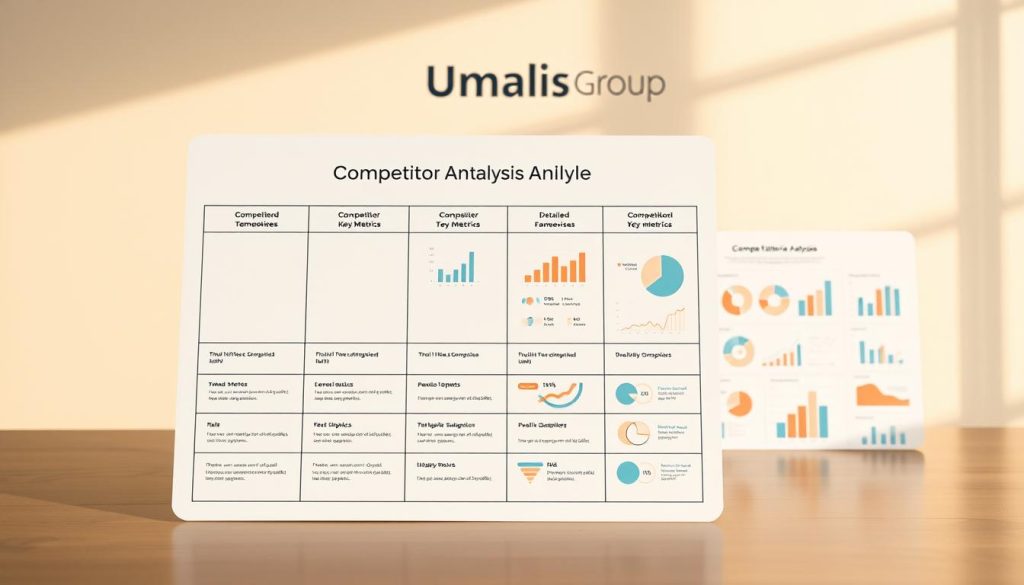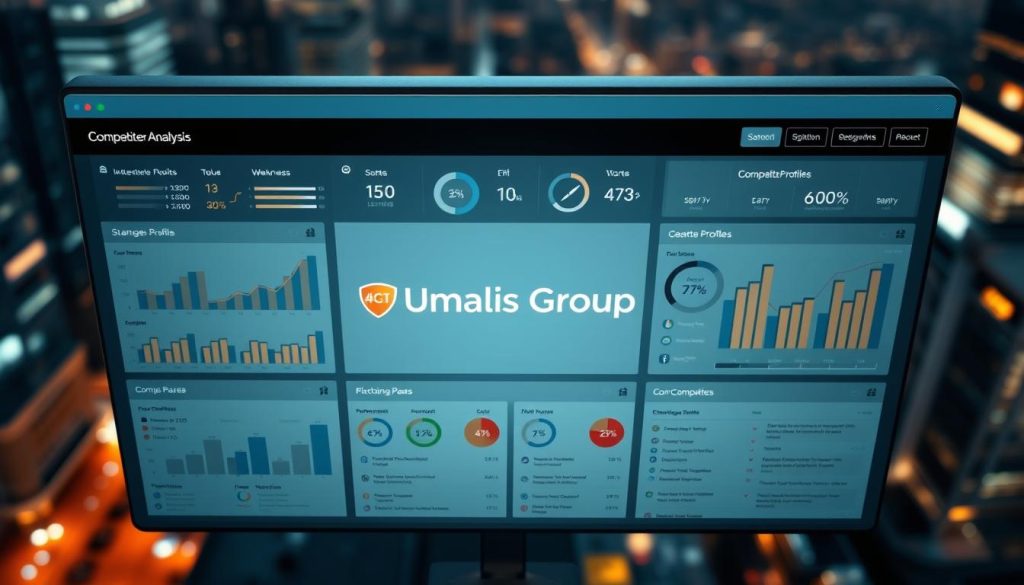As a freelancer in France, navigating the competitive market can be challenging. With over 700,000 new freelancers joining in the last five years, understanding your competitors is crucial for success.
Conducting a competitor analysis allows you to gather valuable insights into your competitors’ business strategies, helping you identify untapped opportunities and develop a unique market strategy. By understanding the competitive landscape, you can refine your business approach, improve your market positioning, and stay ahead in the French freelance ecosystem. For more information on successful freelancing in France, check out our guide on proven tips for freelancing.
Table of Contents
Key Takeaways
- Understand the competitive landscape in the French freelance market.
- Identify key competitors and analyze their business strategies.
- Develop a unique market strategy to stand out.
- Improve your market positioning and stay ahead.
- Gather valuable insights to inform your business decisions.
Understanding the French Freelance Market
To thrive in France’s competitive freelance market, it’s essential to have a deep understanding of the current landscape. The freelance economy in France is experiencing significant growth, driven by an increasing demand for specialized skills.
The Current State of Freelancing in France
The current state of freelancing in France is characterized by intense competition, particularly in specialized fields. According to recent trends, freelancers must differentiate their services to stand out. « The key to success lies in understanding your competitors and identifying gaps in the market that you can fill with your unique skills and service offerings, » emphasizes the importance of competitor analysis.
Freelancers in France are facing a dynamic market where adaptability is crucial. Regular analysis of competitors allows you to stay ahead of industry trends and adjust your business strategy accordingly.
Why Competitor Analysis Matters for French Freelancers
Competitor analysis is vital for French freelancers as it provides insights into local market rates and pricing strategies, helping you position your services competitively. By understanding what other freelancers in your field are doing, you can better articulate your unique value proposition to potential clients in the French market.
Some key benefits of competitor analysis include:
- Identifying market gaps that you can fill with your unique skills.
- Gaining insights into local market rates and pricing strategies.
- Staying ahead of industry trends by regularly analyzing competitors.
By conducting a thorough competitor analysis, French freelancers can develop a robust business strategy that sets them apart in a competitive market.
What is Competitor Analysis?
Competitor analysis is a vital tool for freelancers looking to establish a strong presence in the French market. It involves a comprehensive examination of the competitive landscape to identify key players, understand their strategies, and determine how to differentiate your services.
Definition and Core Concepts
At its core, competitor analysis is about understanding the market metrics that distinguish your offerings from those of your competitors. It goes beyond merely comparing products or services, delving into an in-depth analysis of the competitive landscape. This process helps freelancers identify areas of opportunity and develop strategies to capitalize on them.
The core concepts of competitor analysis include identifying your competitors, assessing their strengths and weaknesses, and understanding their market positioning. By doing so, freelancers can gain valuable insights into the competitive analysis landscape and make informed decisions about their business strategies.
The Difference Between Competitor Analysis and Market Research
While often confused, competitor analysis and market research serve different but complementary purposes in your business strategy. Market research focuses broadly on understanding customer needs, market size, and industry trends. In contrast, competitor analysis specifically examines other businesses in your space, helping you understand how to position yourself within the market.
- Market research identifies potential opportunities, while competitor analysis helps you understand how to position yourself within those opportunities.
- Effective business strategy requires both: market research to understand the landscape and competitor analysis to navigate your position within it.
- Understanding this distinction will help you allocate your research efforts efficiently and gather the most relevant information for your freelance business in France.
By combining these two research approaches, freelancers can develop a comprehensive understanding of the French freelance market and create targeted strategies to succeed.
Benefits of Conducting Competitor Analysis for Freelancers
Conducting a competitor analysis can be a game-changer for freelancers in France, offering insights that can significantly enhance their business strategies. By understanding how their competitors operate, freelancers can identify gaps in the market and opportunities to differentiate their services.
Learning from Others’ Successes and Failures
Analyzing competitors allows freelancers to learn from their successes and failures, gaining valuable insights into what works and what doesn’t in the French market. This knowledge can help freelancers refine their own approaches, avoiding pitfalls and capitalizing on proven strategies. For instance, by examining a competitor’s target audience, a freelancer can identify potential client segments that are not being adequately served.
Discovering Untapped Opportunities in the French Market
Competitor analysis can reveal untapped opportunities in the French market, enabling freelancers to carve out a niche for themselves. By understanding the strengths and weaknesses of their competitors, freelancers can identify areas where they can offer something unique or better. This could involve developing a new value proposition that resonates with the French audience or improving upon existing services offered by competitors.
| Competitor Analysis Benefits | Description |
|---|---|
| Learning from Successes and Failures | Gaining insights into effective strategies and common pitfalls |
| Discovering Untapped Opportunities | Identifying market gaps and new niches |
| Finding Unique Value Proposition | Differentiating services to appeal to the target audience |
Finding Your Unique Value Proposition
A key outcome of competitor analysis is the ability to clearly articulate what makes a freelancer’s services different and better than alternatives in the French market. By understanding what competitors offer, freelancers can identify the unique combination of skills, experiences, and approaches that make their services distinctive. This unique value proposition becomes the foundation of their marketing messages, helping potential clients understand why they should choose them over other freelancers.
Identifying Your Competitors in the French Market
In the competitive landscape of France, identifying your competitors is the first step towards carving out your niche. To start, you need to understand who your competitors are and how they operate in the market.
Direct vs. Indirect Competitors
Direct competitors are those who offer similar services to yours, targeting the same client base. Indirect competitors, on the other hand, may offer related services or have a different business model but still compete for the same budget or client attention. For instance, a freelance writer and a content agency are direct competitors if they both offer writing services. However, a graphic designer and a writing service could be considered indirect competitors if they sometimes collaborate on projects or compete for the same client’s overall budget.
Legacy vs. Emerging Competitors
Legacy competitors are established businesses or freelancers who have been in the market for a while, often with a strong reputation and client base. Emerging competitors are new entrants to the market, potentially with fresh ideas or innovative approaches. Understanding the mix of legacy and emerging competitors can help you identify opportunities to differentiate yourself or capitalize on new trends. For example, a well-established freelance platform like Bizme is a legacy competitor, while new freelance marketplaces are emerging competitors.
Tools to Discover Competitors in France
Several digital tools can help you identify and analyze your competitors in the French market. Tools like Ahrefs and Semrush are invaluable for competitor research, allowing you to see who ranks for the same keywords you’re targeting. Additionally, professional networks like LinkedIn, industry-specific platforms, French business directories, and local chambers of commerce can provide insights into who your competitors are and how they’re positioning themselves in the market.
Creating Your Competitor Analysis Framework

To succeed in the French freelance market, creating a tailored competitor analysis framework is essential. This framework serves as the backbone of your competitive strategy, enabling you to systematically evaluate your competitors and make informed decisions.
Essential Elements to Include in Your Analysis
When building your competitor analysis framework, several key elements should be considered. These include assessing your competitors’ strengths and weaknesses, understanding their market positioning, and analyzing their service offerings. It’s crucial to identify the unique value proposition of your competitors and how it impacts their market share.
- Evaluate competitors’ online presence and marketing strategies
- Assess their pricing models and how they compare to yours
- Analyze customer feedback and reviews to understand their strengths and weaknesses
Customizing Your Framework for the French Market
The French market has its unique characteristics, requiring a customized approach to competitor analysis. French business culture, regulatory requirements, and local market conditions should all be taken into account. For instance, understanding the implications of auto-entrepreneur status and local tax considerations can provide valuable insights into your competitors’ strategies.
As noted by a business strategy expert, « Thorough market research doesn’t just highlight these differences, it also leverages them. This lays a solid foundation for a sales and marketing strategy that differentiates your business in a bustling market. »
« The key to successful competitor analysis is not just to identify your competitors, but to understand their strategies and how they impact your business. »
By adapting your competitor analysis framework to the French market, you can ensure that your insights are relevant and actionable, ultimately informing a competitive strategy that sets you apart.
Step-by-Step Competitor Analysis Process
A well-executed competitor analysis enables French freelancers to make informed decisions about their business strategies. This process involves several key steps that help you understand your competitors and the market landscape.
Gathering Initial Information
The first step in conducting a competitor analysis is gathering initial information about your competitors. This involves identifying their strengths, weaknesses, and market positioning. You can start by researching their online presence, including their website, social media profiles, and any other digital platforms they use. It’s also crucial to gather information about their services, pricing models, and target audience. Creating a standardized template or framework for recording this information ensures consistency across your analysis.
Analyzing Competitors’ Services and Offerings
Once you have gathered initial information, the next step is to analyze your competitors’ services and offerings in detail. This includes evaluating the quality of their work, their unique selling propositions (USPs), and how they differentiate themselves from others in the market. You should also assess their customer service, client relationships, and any other factors that contribute to their competitive advantage. By doing so, you can identify gaps in the market that your own freelance business can fill.
Documenting Your Findings Effectively
Documenting your findings is a critical part of the competitor analysis process. It’s essential to record all your findings in a competitive analysis report, which should include both quantitative data (such as pricing, years in business, number of services) and qualitative assessments (such as brand positioning, perceived quality, client relationships). Organizing your findings in a way that facilitates easy comparison between competitors and highlights patterns or trends in the French freelance market is key. Establishing a regular schedule for updating your competitor analysis documentation ensures that your insights remain relevant and actionable.
By following this step-by-step competitor analysis process, freelancers in France can gain valuable insights into their competitors and the market, ultimately informing their business strategies and helping them to stand out in a competitive landscape.
Analyzing Competitors’ Marketing Strategies
To gain a competitive edge, it’s essential to analyze the marketing strategies employed by your competitors in France. This analysis will help you understand how to position your freelance services effectively.
Website and Online Presence Evaluation
Begin by evaluating your competitors’ websites and overall online presence. Assess the design, user experience, and functionality of their sites. Look for elements such as search engine optimization (SEO), mobile responsiveness, and loading speed. A well-designed website can significantly enhance a competitor’s visibility and credibility. Examine how they utilize their online presence to showcase their services, share testimonials, and engage with their audience.
Social Media Strategy Assessment
Next, analyze your competitors’ social media strategies. Identify the platforms they use most frequently and assess the content they share. Look at the types of posts, the frequency of posting, and the level of engagement they receive. Understanding their social media approach can provide insights into how they build their brand and interact with potential clients. Pay attention to how they leverage social media to promote their services and drive traffic to their websites.
Content Marketing Approaches
Examine the various types of content your competitors produce, such as articles, videos, podcasts, guides, or courses. Assess the topics and themes they focus on, and identify potential content gaps you could fill. Evaluate the quality, depth, and uniqueness of their content, noting whether they’re creating valuable resources or simply producing content for SEO purposes. Analyze how they distribute their content and whether they’re effectively using it to nurture leads and convert prospects into clients in the French market.
By thoroughly analyzing your competitors’ marketing strategies, you can gain valuable insights into the French freelance market and develop a more effective strategy for your own business.
Evaluating Pricing Strategies in the French Market
Understanding the pricing landscape is crucial for freelancers operating in the French market. Developing a competitive pricing strategy requires balancing market expectations with your unique value proposition as a freelancer in France.
Common Pricing Models for Freelancers in France
Freelancers in France often adopt various pricing models to suit different client needs and project requirements. Common models include hourly rates, project-based pricing, and retainer-based agreements. When choosing a pricing model, consider factors such as your expertise, the level of competition, and the value you bring to clients.
- Hourly rates are straightforward but may not reflect the overall value delivered.
- Project-based pricing allows for flexibility and can be attractive for clients with specific needs.
- Retainer-based agreements provide a predictable income stream and foster long-term client relationships.
How to Position Your Rates Competitively
Rather than simply matching or undercutting competitors’ rates, focus on clearly communicating the distinct value and benefits you provide to justify your pricing. Consider how factors such as specialization, experience, and additional services can support premium pricing in the French market. Developing pricing tiers or packages that address different client needs and budgets can help maintain profitability while appealing to a broader client base.
By focusing on the unique benefits you offer and understanding the needs of your target market, you can establish a pricing strategy that supports your freelance business goals and resonates with clients in France.
Assessing Competitors’ Strengths and Weaknesses

A comprehensive competitor analysis involves identifying the strengths and weaknesses of your competitors in the French market. This assessment is crucial for understanding the competitive landscape and developing strategies to differentiate your services.
Identifying Key Differentiators
Key differentiators are the unique aspects that set your competitors apart from others in the market. To identify these differentiators, analyze your competitors’ services, marketing strategies, and customer engagement. Look for patterns in their strengths and weaknesses to understand what clients value most in the French market.
Analyzing Customer Feedback and Reviews
Customer feedback and reviews provide valuable insights into your competitors’ strengths and weaknesses. Analyze online reviews, testimonials, and client surveys to understand how customers perceive your competitors’ services and identify areas for improvement. This information can help you tailor your services to meet the needs of your target market.
Finding Gaps in Competitors’ Services
Identifying gaps in your competitors’ services can reveal opportunities for your freelance business to stand out. Look for client needs that competitors are failing to address fully, whether in terms of service scope, quality, availability, or specialized expertise. Consider whether there are emerging needs or trends that established competitors have been slow to recognize or adapt to.
| Competitor Strengths | Competitor Weaknesses | Opportunities for Your Business |
|---|---|---|
| Strong online presence | Limited service offerings | Develop specialized services to fill gaps |
| High-quality services | Poor customer engagement | Improve customer interaction and feedback |
| Established client base | Outdated marketing strategies | Leverage modern marketing techniques to attract new clients |
Conducting a SWOT Analysis for Your Freelance Business
A SWOT analysis can be a game-changer for freelancers looking to navigate the competitive French market effectively. This strategic tool allows you to assess your business’s strengths and weaknesses, as well as identify opportunities and threats in the market.
Strengths and Weaknesses Assessment
Evaluating your freelance business’s strengths and weaknesses is a crucial step in the SWOT analysis. Your strengths might include your expertise, a strong professional network, or a robust portfolio. On the other hand, weaknesses could be areas where you lack experience, high dependency on a few clients, or inefficient business processes. To conduct this assessment effectively:
- List your key strengths that give you a competitive edge.
- Identify areas of weakness that need improvement.
- Consider how your strengths can help mitigate your weaknesses.
Identifying Opportunities and Threats in the French Market
The external components of your SWOT analysis focus on market conditions and competitive forces in the French freelance landscape. Opportunities might include emerging market niches, evolving client needs, or new technologies that align with your strengths. Conversely, threats could encompass increasing competition, regulatory changes, or economic factors impacting client budgets. To identify these effectively:
- Research emerging trends and opportunities in the French freelance market.
- Assess potential threats, including competition and regulatory changes.
- Consider how broader trends in the French economy might impact your business.
By conducting a thorough SWOT analysis, you can develop proactive strategies to enhance your competitive position in the French freelance market.
Turning Competitor Analysis into Actionable Strategies
After conducting a thorough competitor analysis, it’s time to leverage those insights into actionable strategies that set you apart in the French freelance market. This involves a multi-faceted approach that not only differentiates your services but also creates a compelling value proposition that attracts new clients.
Developing Your Unique Value Proposition
Your unique value proposition (UVP) is the cornerstone of your freelance business, distinguishing you from competitors. To develop a compelling UVP, consider what product features or service delivery innovations you can offer that are not readily available from your competitors. Ask yourself, « What design features can I add to my brand to make it stand out? » By focusing on these differentiators, you can craft a UVP that resonates with your target audience.
Creating a Competitive Marketing Plan
A competitive marketing plan is crucial for reaching new clients and growing your freelance business in France. This involves assessing your competitors’ marketing strategies and identifying gaps that you can exploit. Consider developing strategic partnerships or collaborations that complement your services, creating offerings that competitors can’t easily match. By leveraging these insights, you can create a marketing plan that effectively targets your audience.
Setting Yourself Apart in the French Freelance Market
To stand out in the French freelance market, you need to innovate and differentiate your services continuously. Explore specialization opportunities in underserved niches or client segments identified through your competitor analysis. Establishing thought leadership through content, speaking engagements, or community involvement can also build your reputation and set you apart from competitors. By adopting these strategies, you can maintain a competitive edge and attract new clients.
As emphasized by a successful freelancer, « The key to success lies in understanding your competitors and differentiating your services in a way that adds unique value to your clients. » By following these steps, you can turn your competitor analysis into actionable strategies that drive your freelance business forward.
Common Competitor Analysis Mistakes to Avoid
To reap the benefits of competitor analysis, French freelancers must navigate its challenges by avoiding common mistakes. Competitor analysis is a critical tool for understanding the market, identifying opportunities, and developing a competitive strategy. However, its effectiveness can be undermined by several pitfalls.
Focusing Only on Direct Competitors
One of the most significant mistakes freelancers make is focusing solely on direct competitors. While it’s essential to understand who you’re competing against directly, ignoring indirect competitors can provide a skewed view of the market. Indirect competitors may offer different services or solutions that still compete for your target audience’s attention and budget.
For instance, a freelance web developer might directly compete with other web developers, but they also compete indirectly with website builders and digital agencies that offer web development services. Understanding this broader competitive landscape can help you identify untapped opportunities and differentiate your services more effectively.
Neglecting to Update Your Analysis Regularly
The competitive landscape is not static; it evolves with new entrants, changing consumer behaviors, and technological advancements. Neglecting to update your competitor analysis regularly can leave you out of touch with the current market dynamics. Regular updates ensure that your strategy remains relevant and responsive to the changing environment.
Schedule regular reviews of your competitor analysis to stay informed about new competitors, changes in competitors’ strategies, and shifts in market trends. This proactive approach enables you to adjust your strategy in a timely manner, staying competitive in the French freelance market.
Copying Instead of Learning
Perhaps the most dangerous mistake in competitor analysis is attempting to directly imitate successful competitors rather than developing your own distinctive approach.
« The goal of competitor analysis is to learn from others’ approaches and then develop your own authentic and differentiated strategy for the French market. »
Simply copying competitors’ strategies without understanding the underlying principles or adapting them to your unique strengths rarely leads to success.
Mindless imitation can damage your reputation and position you as a second-rate alternative rather than a distinctive choice for clients. Instead of copying, focus on understanding why certain approaches work for competitors and how you might apply similar principles in ways that align with your unique skills and brand.
Conclusion
Competitor analysis is not just a theoretical exercise, but a practical tool that can transform your freelance business in France. By systematically analyzing your competitors, you gain valuable insights that inform your positioning, service development, pricing, and marketing strategies. This process helps you identify both immediate opportunities and long-term strategic directions for your freelance business in France.
As a freelancer in France, your ability to understand the competitive landscape and adapt accordingly will be a significant factor in your long-term success and sustainability. Regular competitor analysis is crucial to account for shifts in competitors’ tactics and new competitors that arrive on the scene. We encourage you to apply the frameworks and methodologies outlined in this guide to conduct your own thorough competitor analysis.
By doing so, you can develop a distinctive position in the market that leverages your unique strengths and addresses genuine client needs. With regular competitive analysis and strategic application of the insights you gather, you can build a thriving freelance business that stands out in the French market. Remember, effective competitor analysis is ongoing—the market evolves, competitors change their approaches, and new players emerge regularly.
To maintain a competitive edge, return to your competitor analysis efforts regularly, such as every quarter, six months, or year. This will enable you to stay ahead of the competition and make informed decisions about your business. By making competitor analysis a regular part of your business strategy, you can ensure long-term success and sustainability in the French freelance market.
FAQ
What is the primary goal of conducting a competitor analysis as a freelancer in France?
The primary goal is to understand the competitive landscape, identify gaps in the market, and develop strategies to differentiate your services and gain a competitive edge.
How do I identify my competitors in the French freelance market?
You can identify your competitors by using online directories, social media, and professional networks. Tools like Crunchbase, LinkedIn, and freelance platforms can help you discover other freelancers offering similar services.
What is the difference between direct and indirect competitors?
Direct competitors offer the same services as you, targeting the same audience. Indirect competitors may offer related services or target a similar audience, but their offerings are not identical to yours.
How often should I update my competitor analysis?
It’s recommended to update your competitor analysis regularly, ideally every 3-6 months, to stay informed about changes in the market, new competitors, and shifts in customer needs.
Can I use competitor analysis to inform my pricing strategy?
Yes, analyzing your competitors’ pricing models can help you position your rates competitively and make informed decisions about your pricing strategy.
What are some common mistakes to avoid when conducting a competitor analysis?
Common mistakes include focusing only on direct competitors, neglecting to update your analysis regularly, and copying competitors’ strategies instead of learning from them and developing your unique approach.
How can I use competitor analysis to develop my unique value proposition?
By analyzing your competitors’ strengths and weaknesses, you can identify areas where you can differentiate your services and develop a unique value proposition that sets you apart in the French freelance market.





